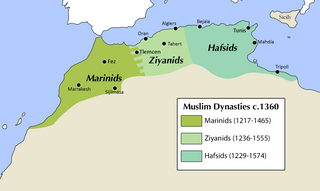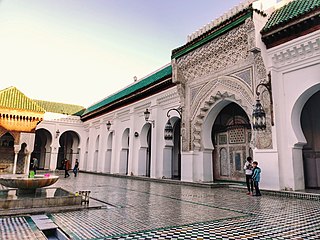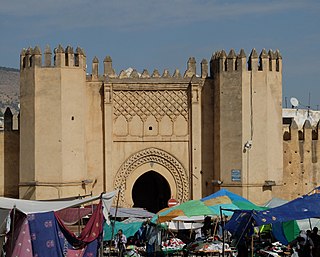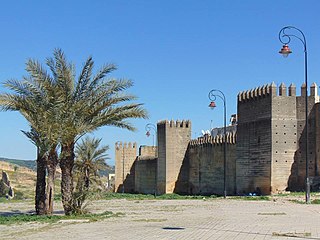This article needs additional citations for verification .(December 2024) |
| History of Morocco |
|---|
 |
The Imperial Cities of Morocco are the four historical capital cities of Morocco: Fez, Marrakesh, Meknes and Rabat. [1]
This article needs additional citations for verification .(December 2024) |
| History of Morocco |
|---|
 |
The Imperial Cities of Morocco are the four historical capital cities of Morocco: Fez, Marrakesh, Meknes and Rabat. [1]
Founded by Idris I between 789 and 808, the town of Fez was the capital city several times:

Marrakesh is considered a symbol of Morocco and the power of the Almoravid and Almohad dynasties. It was founded in 1071 and became the capital for the two following centuries.
Marrakesh was the capital city for:
Meknes was the capital under the Alawi sultan Ismail Ibn Sharif (r. 1672–1727), who built its walls and made it his capital. He rebuilt and expanded its old kasbah into a new monumental palace-city to the south of the old city.

Rabat was founded by the Almohad caliph Yaqub al-Mansur with the aim of serving as his capital, but the project was abandoned after he died and Marrakesh remained the capital city.
In the 18th century, Rabat was designated an imperial city by the Alawi sultan Muhammad ibn Abdallah, who built the Dar al-Makhzen, although he did not designate any city as his capital, moving continually between Rabat, Fez and Marrakech.
The history of human habitation in Morocco spans since the Lower Paleolithic, with the earliest known being Jebel Irhoud. Much later Morocco was part of Iberomaurusian culture, including Taforalt. It dates from the establishment of Mauretania and other ancient Berber kingdoms, to the establishment of the Moroccan state by the Idrisid dynasty followed by other Islamic dynasties, through to the colonial and independence periods.

The Marinid dynasty was a Berber Muslim dynasty that controlled present-day Morocco from the mid-13th to the 15th century and intermittently controlled other parts of North Africa and of the southern Iberian Peninsula (Spain) around Gibraltar. It was named after the Banu Marin, a Zenata Berber tribe originally from Algeria. It ruled the Marinid sultanate, founded by Abd al-Haqq I.

Moroccan architecture reflects Morocco's diverse geography and long history, marked by successive waves of settlers through both migration and military conquest. This architectural heritage includes ancient Roman sites, historic Islamic architecture, local vernacular architecture, 20th-century French colonial architecture, and modern architecture.

The history of the Jews in Morocco goes back to ancient times. Moroccan Jews constitute an ancient community. Before the founding of the State of Israel in 1948, there were about 265,000 Jews in the country, with a maximum of between 250,000 and 350,000 at its peak in the 1950s, which gave Morocco the largest Jewish community in the Muslim world, but by 2017 only 2,000 or so remained. Jews in Morocco, originally speakers of Berber languages, Judeo-Moroccan Arabic or Judaeo-Spanish, were the first in the country to adopt the French language in the mid-19th century, and unlike among the Muslim population French remains the main language of members of the Jewish community there.

Maghrebiscript or Maghribi script or Maghrebi Arabic script refers to a loosely related family of Arabic scripts that developed in the Maghreb, al-Andalus (Iberia), and Bilad as-Sudan. Maghrebi script is directly derived from the Kufic script, and is traditionally written with a pointed tip, producing a line of even thickness.

The Wattasid dynasty was a ruling dynasty of Morocco. Like the Marinid dynasty, its rulers were of Zenata Berber descent. The two families were related, and the Marinids recruited many viziers from the Wattasids. These viziers assumed the powers of the Sultans, seizing control of the Marinid dynasty's realm when the last Marinid, Abu Muhammad Abd al-Haqq, who had massacred many of the Wattasids in 1459, was murdered during a popular revolt in Fez in 1465.

The Zawiya of Moulay Idris II is a zawiya in Fez, Morocco. It contains the tomb of Idris II, who ruled Morocco from 807 to 828 and is considered the main founder of the city of Fez. It is located in the heart of Fes el-Bali, the UNESCO-listed old medina of Fez, and is considered one of the holiest shrines in Morocco. The current building experienced a major reconstruction under Moulay Ismail in the early 18th century which gave the sanctuary its overall current form, including the minaret and the mausoleum chamber with its large pyramidal roof.

The history of Marrakesh, a city in southern Morocco, stretches back nearly a thousand years. The country of Morocco itself is named after it.

Fez or Fes is a city in northern inland Morocco and the capital of the Fez-Meknes administrative region. It is one of the largest cities in Morocco, with a population of 1.256 million, according to the 2024 census. Located to the northwest of the Atlas Mountains, it is surrounded by hills and the old city is centered around the Fez River flowing from west to east. Fez has been called the "Mecca of the West" and the "Athens of Africa". It is also considered the spiritual and cultural capital of Morocco.
The following is a timeline of the history of the city of Tangier, Morocco.
The following is a timeline of the history of the city of Fez, Morocco.
The following is a timeline of the history of the city of Marrakesh, Morocco.
Guich tribes, Gish tribes, or Jaysh tribes, or sometimes Makhzen tribes, were tribes of usually Arab origin organized by the sultans of Moroccan dynasties under the pre-colonial Makhzen regime to serve as troops and military garrisons, as well as to protect the outskirts of the capital and suppress rebellions. They were usually cantoned in their own lands and maintained a state of perpetual military mobilization. The contingents were formed in order to be loyal to the sultan only instead of to other local interests, but they often maintained a coherent group identity long after the death of the sultan and were sometimes the source of political instability. The historical guich system took shape primarily under the reign of the 'Alawid sultan Mawlay Isma'il, although variations of similar military organisations were used by prior rulers and dynasties. The major historical guich tribes were the Cheraga, the Udayas, the Cherarda, and the Bwakher. The guich constituted one of the main parts of the Moroccan army.
Sidi Said, Morocco is a hamlet in Morocco located at 28° 27' 36" North, 10° 34' 12" was one of five castra that, during the Roman period, guarded the city of Volubilis from incursion over the nearby Limes Africanus. Sidi Said was the base for the Cohors IV Gallorum equitata, an auxiliary cavalry unit from Gaul. Rome's control over the area ended, however, following the chaos of the Crisis of the Third Century, when the empire nearly disintegrated as a series of generals seized and lost power through civil wars, palace coups and assassinations.

The Kasbah An-Nouar or Kasbah Filali is a walled district and former military enclosure in the old medina of Fez, Morocco. Its name means "citadel of the flowers", but it is sometimes also referred to as Kasbah Filala and Kasbah Chorfa. It is one of several fortified military enclosures or kasbahs that were built around the old city of Fez across different periods.

The Fortifications of Fez comprise a complex circuit of ramparts and gates surrounding Fes el-Bali and Fes el-Jdid, two urban agglomerations that compose the old "medina" of Fes, Morocco. They also include a number of kasbahs (citadels) and forts which were built both to protect and to control the city. These fortifications have been built up over many centuries and the extensive remnants today date from many different periods.

The architecture of Fez, Morocco, reflects the wider trends of Moroccan architecture dating from the city's foundation in the late 8th century and up to modern times. The old city (medina) of Fes, consisting of Fes el-Bali and Fes el-Jdid, is notable for being an exceptionally well-preserved medieval North African city and is classified as a UNESCO World Heritage Site. A large number of historic monuments from different periods still exist in it today, including mosques, madrasas, synagogues, hammams (bathhouses), souqs (markets), funduqs (caravanserais), defensive walls, city gates, historic houses, and palaces.

The Kasbah of Marrakesh is a large walled district in the southern part of the medina of Marrakesh, Morocco, which historically served as the citadel (kasbah) and royal palace complex of the city. A large part of the district is still occupied by the official royal palace, the Dar al-Makhzen, which serves as the residence of the King of Morocco when he visits the city. The rest of the district consists of various neighbourhoods and monuments. It was founded by the Almohads in the late 12th century, with most of the construction carried out by Caliph Ya'qub al-Mansur. Two of its most important surviving structures today, the Kasbah Mosque and the main gate of Bab Agnaou, date from al-Mansur's reign.

The History of Fez begins with its foundation by Idris I and Idris II at the end of the 8th century and the beginning of the 9th century CE. It initially consisted of two autonomous and competing settlements on opposing shores of what is now known as the Oued Fes. Initially inhabited by a largely Berber (Amazigh) population, successive waves of mainly Arab immigrants from Ifriqiya (Tunisia) and al-Andalus (Spain/Portugal) over time gave the nascent city an Arab character as well. After the downfall of the Idrisid dynasty, it was contested between different Zenata groups allied with either the Fatimid Caliphate or the Umayyad Caliphate of Cordoba. In the 11th century the Almoravid sultan Yusuf ibn Tashfin conquered the region and united its two settlements into what is today the Fes el-Bali quarter. Under the rule of the Almoravids and of the Almohads after them, despite losing the status of capital to Marrakesh, the city remained the economic and political center of northern Morocco and gained a reputation for religious scholarship and mercantile activity.
Sharifism is a term used to describe the system in pre-colonial Morocco in which the shurafā'—descendants of the Islamic prophet Muhammad —held a privileged religious and political position in society. Those who claimed this lineage were regarded as a kind of nobility and were privileged, in the words of Sahar Bazzaz, "as political agents, as interlocutors between various sectors of society, and as would be dynasts of Morocco". They were additionally believed to possess baraka, or blessing power. Claiming this lineage also served to justify authority; the Idrisi dynasty (788–974), the Saadi dynasty (1510–1659), and the 'Alawi dynasty (1631–present) all claimed lineage from Ahl al-Bayt.